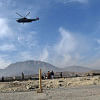World leaders who died in air crashes

Following the Iranian president's death in a helicopter crash, the whole world is shocked. But throughout history, the death of presidents, prime ministers, and monarchs in aviation related accidents is not uncommon, as they frequently move about in planes and helicopters, exposing themselves to the risk of accident and sabotage.
As the facts behind the accident slowly reveal themselves, let us look at some other notable world leaders who have succumbed to their deaths in aviation related accidents and incidents.
Ramon Magsaysay, Philippines
Hailed as the "Champion of the masses" and the "Defender of democracy", Ramon Magsaysay was possibly the most popular leader in modern day Philippines. His government had gained high levels of trust from the public for its clean image, and people-centric policies. President Magsaysay had spoken at multiple universities and been conferred an honorary doctorate degree on March 16, 1957. On his way back to Manila the next day, however, his plane crashed into Mount Manunggal in Cebu, Philippines. All but one passenger were killed, including the president.
Dag Hammarskjöld, United Nations
The second secretary-general of the UN, Dag Hammarskjöld of Sweden was once called the "greatest statesman of our century" by John F Kennedy. In the height of the Cold War, his name came forward as a candidate to lead the UN as a brilliant economist and bureaucrat, a choice who would be acceptable to both the US and the Soviet Union. He played crucial roles as mediator between Israel and the Arab States, between China and the US, and as a force for African decolonisation. His involvement in the Congo Crisis is what eventually killed him, however, as a plane carrying him to a ceasefire negotiation crashed in Northern Rhodesia (modern day Zambia) on September 18, 1961. There is confusion over the cause of the crash, as some claim that it was due to pilot error, while the Americans claimed that the Soviets killed him.
Rashid Karami, Lebanon
A record-holder for being elected to be a prime minister on eight occasions, Rashid Karami was one of the most important political figures in 20th century Lebanon, and the Middle East in general. He was the leader of Lebanon during the demographic shift which saw Muslims becoming the majority population group in a hitherto Christian dominant country. He fought for better Muslim representation in the Lebanese government, championed the Pan-Arab and Palestinian causes, and played a major role in the Lebanese Civil War, after which he was appointed Prime Minister in 1984. On June 1, 1987, a helicopter carrying him was rigged with a remote controlled bomb, which exploded mid-air and killed him. A Maronite militia leader, part of the Christian armed groups that Karimi fought during the civil war, was accused of his assassination.
Muhammad Zia-ul-Haq, Pakistan
A military leader who went on to become the President of Pakistan, Muhammad Zia-ul-Haq was the proponent for a heavily Islam-influenced nation of Pakistan. His legacy is much discussed and often controversial in the history of the Indian subcontinent, as he consolidated Pakistan's efforts to pursue nuclear arms and worked to undo the balance of power established by India after the Bangladesh Liberation War of 1971. He died in a plane crash on August 17, 1988, after observing an arms display in the Punjab province. Alongside him, other military leaders and the US ambassador to Pakistan also perished. In Pakistan, there were accusations that the Soviet Union was behind the crash, given Zia-ul-Haq's support for the Afghan mujahideen in the Soviet invasion of Afghanistan.
Juvénal Habyarimana, Rwanda
The Rwandan Civil War between 1990 and 1994, and the Rwandan genocide that took place near the end of it, features prominently the name of Juvénal Habyarimana. He became president in 1973, remaining in power for over two decades, during which time the Hutu majority of Rwanda was favoured massively by the Habyarimana (himself a Hutu) government. Once the civil war started, Habyarimana took the help of external powers to maintain control, a decision that led to terrible consequences for Rwandan civilians. On April 6, 1994, his plane was shot down near Kagali International Airport. Alongside him, Cyprien Ntaryamira, the President of Burundi, was also killed. Current Rwandan president Paul Kagame has been accused by various parties for the assassination, but Kagame maintains that the killing was ordered by Hutu leaders to aggravate the militias who carried out the genocide of the Tutsi minority group following Habyarimana's assassination.
Lech Kaczyński, Poland
On April 10, 2010, Lech Kaczyńskiw, the President of Poland, was travelling to Russia to commemorate the Katyn massacre—an incident where 22,000 Polish military officers were killed by the Soviet Union. Ironically, this is the journey that killed the then sitting president of Poland, in a plane crash near Smolensk in Russia. A total of 96 people were killed, and an investigation committee headed by then Russian PM Vladimir Putin was formed. Kaczyński, during his five-year presidency, was vocal against the Russian invasion of Georgia and provided support to the former Soviet nation during the war. Some claimed that the Russian government was behind his killing, and a 2016 Polish government investigation revealed that the body parts of many of the victims were mismatched in their coffins during the recovery of bodies and subsequent burial.
Ebrahim Raisi, Iran
On May 19, 2024, a helicopter carrying Iranian president Ebrahim Raisi crashed near the Azerbaijani border, and he, alongside his foreign minister, died in the crash. The cause behind the crash is not clear yet, but due the ongoing Israeli invasion of Gaza and an escalation of tensions between Israel and Iran just weeks ago, the world has shifted its focus to the Middle East once again, hoping that this is not a prelude to more death and bloodshed.


 For all latest news, follow The Daily Star's Google News channel.
For all latest news, follow The Daily Star's Google News channel. 







Comments